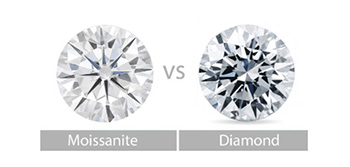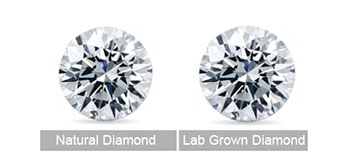Lab Grown Diamonds
Lab Grown Diamonds have the exact same chemical properties as Natural Diamonds which makes the two identical.
The only difference between Lab Grown Diamonds and Natural Diamonds is their origin. Natural Diamonds are created under the earth’s crust over millions of years whereas; Lab Grown Diamonds are created in a lab. Advanced technology is used to create Lab Grown Diamonds by mimicking the conditions in which Natural Diamonds form.
You may have heard of Lab Grown Diamonds being referred to as engineered diamonds, man-made diamonds or cultured diamonds.
Lab Grown Diamonds start as tiny carbon seeds, which is a miniscule slice of a diamond, and using intense heat and pressure they grow into large rough diamonds. Those rough diamonds are then cut and polished, just like a natural diamond.
Lab Grown Diamonds are real diamonds and it’s almost impossible to differentiate between Natural and Lab Grown Diamonds. Only a professional gemmologist using specialist equipment can tell the two apart. They will see the minor differences in trace elements and crystal growth which differentiate the Natural and Lab Grown Diamonds.
Side by side you could not differentiate a Natural and Lab Grown Diamond, of similar specification, based on the origin.
With Lab Grown Diamonds being identical and made of the same material as Natural Diamonds they also sparkle in the same way. Lab Grown Diamonds are not flawless; they are graded using the same scale as Natural Diamonds.
Lab Grown Diamonds offer great value for money. Depending on the specifications they can be around 30-60% lower in cost than Natural Diamonds.
The choice that you make for the diamond origin in the ring will be the same for all of the diamonds in the ring. For instance, if you select Lab Grown Diamonds for a Halo design then all of the diamonds will be Lab Grown.
It is important not to confuse Lab Grown Diamonds with Cubic Zirconia or Moissanite which are diamond stimulants. A diamond stimulant is something which imitates a diamond but does not possess the same properties. As we know, a Lab Grown Diamond has the same properties as a Natural Diamond.
The difference between stimulants compared to a Natural or Lab Grown Diamond is distinguishable to the naked eye. This is shown in the below images.

Moissanite stones are double refractive, this means when a ray of light passes through the stone it is slowed, bent and split into two which affects the light return and sparkle. A diamond is single refractive so when light passes through the diamond it travels in a straight line making the diamond brighter, clearer and more sparkly.

How are Lab Grown Diamonds made?
The two main ways Lab Grown Diamonds are created are High Pressure High Temperature which known as HPHT and Chemical Vapour Deposition which is known as CVD.
Both HPHT and CVD methods start with a tiny carbon seed from a pre-existing diamond and then mimic the conditions of a natural diamond forming.
The difference between a HPHT and a CVD diamond is not visible to the naked eye. Both methods create stunning diamonds but CVD is the most popular method currently and most Lab Grown Diamonds we source are CVD.
CVD diamonds are grown by placing a diamond plate into a vacuum chamber and injecting that with a hydrocarbon gas, such as methane. High power microwave energy is then used to break down the atomic bonds of the hydrocarbon gas which separates the carbon atoms from the hydrogen atoms resulting in free carbon. This then falls down onto the diamond plates and the diamond grows atom by atom.
The process of growing diamonds using the HPHT method is similar to the CVD. In the HPHT method growth occurs within a large pressure cooker called a cubic press. To grow a diamond in a cubic press small diamond seeds are placed inside a growth cell and a layer of additional carbon is placed on top of the seeds. The growth cell is then placed in the centre of the cubic press and heated to temperatures reaching 1500°, as well as this intense heat 1 million psi of pressure is also applied. Under these conditions a diamond crystal is formed.
After both diamond growing processes the rough stones which has been created must then be cut and polished. For this reason, you may find that the price difference between Lab Grown and Natural diamonds for some jewellery designs, like half eternity rings or clusters of small diamonds in earrings or pendants, isn’t that great. This is because of the work which goes in to cutting and polishing each diamond so the cost begins to level out. You will see a real difference in price with larger diamonds like those in an engagement ring.
Are Lab Grown Diamonds more ethical?
It is thought generally that lab grown diamonds are the more ethical choice.
Lab Grown Diamonds aren’t required to be mined and the mining process is known to be harmful to the environment. The mining process has been known, historically, to have poor working conditions.
With the process of creating Lab Grown Diamonds it is easier to get information on the supply chain in terms of working conditions and exactly where the diamond has came from.
While it is generally thought that Lab Grown Diamonds are more ethical Natural Diamond mining companies have made significant improvements in becoming more environmentally friendly, as well as great improvements to working conditions.
Every single Natural Diamond which we source are from legitimate suppliers and all diamonds adhere to the Kimberley Process rules. You can see more information on Ethical Diamond Buying here.
Natural Diamonds do also have their benefits in terms of helping communities. Natural Diamonds support employment and economic growth with many countries, including, Botswana, Angola and South Africa, having benefitted from the diamond industry.
If every diamond sold worldwide was to be lab grown this would negatively impact many communities who rely on the industry.
Both Lab Grown and Natural Diamonds come with their own pros. We have listed some of those below
Pros of Lab Grown Diamonds
- Lab Grown Diamonds come at a lower price than Natural
- They do not require any mining which can be harmful to the environment
- It can be easier to get information on their supply chain
Pros of Natural Diamonds
- Natural Diamonds are often thought to be more romantic as they’re part of the world’s history after being grown for billions of years
- The value is unlikely to decrease over time but likely to increase
- Natural Diamonds are more rare than lab grown
FAQ’s
What is a Lab Grown Diamond?
A Lab Grown Diamond is a diamond which has been created in a lab using advanced technology to mimic the conditions in which Natural Diamonds are created.
What is the difference between Natural and Lab Grown Diamonds?
Natural diamonds are grown beneath the earth’s crust over billions of years, whereas, a Lab Grown diamond is created using advanced technology in a controlled environment.
Lab Grown diamonds are identical to natural diamonds as both have the same chemical properties.
Are Lab Grown Diamonds real?
Yes, they are real diamonds. Lab Grown diamonds are formed using natural diamond seeds or plates which are then grown to create a real and genuine diamond. The process just takes place in a lab rather than underneath the earth’s crust.
How are they graded?
Lab Grown Diamonds are graded in the same way as Natural Diamonds and using the same scale which takes into account the 4 C's.
Are Lab Grown Diamonds flawless?
Lab Grown diamonds are created in an environment which mimics that of the natural diamond forming process which means imperfections can still occur. Lab Grown Diamonds can still have inclusions and presence of colour which is why the 4 C’s still apply.
Are Lab Grown Diamonds treated?
All of our Lab Grown and Natural diamonds are untreated. They have not received any treatments or been enhanced in any way.






